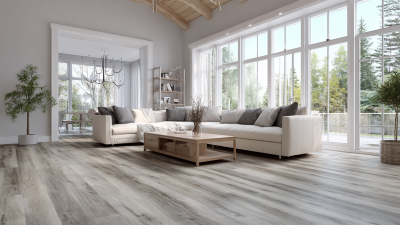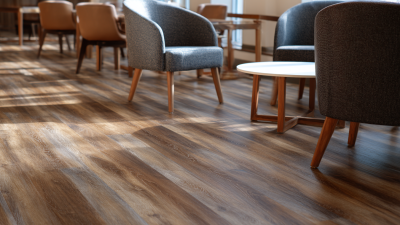As the demand for eco-friendly and sustainable building materials continues to rise, SPC rigid core flooring is emerging as a game changer in the interior design industry. According to a report by the Global Market Insights, the global green building materials market is projected to reach over $600 billion by 2027, indicating a significant shift towards sustainable options in construction and renovation. SPC rigid core flooring, made from a combination of stone plastic composite, offers durability and resilience while minimizing environmental impact, making it an ideal choice for conscious consumers. Additionally, its ease of installation and maintenance further positions SPC rigid core flooring as a frontrunner in the market, appealing to both homeowners and commercial developers alike. This innovative flooring solution not only supports sustainability goals but also enhances the aesthetic appeal of interior spaces, showcasing how ecological responsibility can harmoniously coexist with design elegance.

As the interior design industry evolves, the demand for eco-friendly flooring solutions has surged significantly. Consumers are increasingly aware of the environmental impact of their choices, leading to a preference for sustainable materials that do not compromise on aesthetic appeal or durability. The growth of SPC (Stone Plastic Composite) rigid core flooring exemplifies this trend, as it combines sustainability with high performance, making it an attractive option for contemporary interiors.
The luxury vinyl tile (LVT) market is also responding to this demand, projected to reach $46.3 billion by 2030, growing at a CAGR of 8.1%. The rise in custom and designer-inspired LVT collections reflects a shift towards greater personalization and eco-consciousness in flooring options. Similarly, the U.S. carpet and rug market is expected to expand significantly, indicating a robust interest in versatile flooring solutions that align with sustainable interior design principles. As consumers continue to prioritize eco-friendly choices, the flooring industry is adapting, ensuring that aesthetics, functionality, and environmental impact harmoniously coexist.

SPC rigid core flooring is emerging as a frontrunner in the sustainable interior design movement, thanks to its impressive environmental benefits compared to traditional flooring options. One of the primary advantages of SPC is its composition, which utilizes recycled materials, reducing the need for virgin resources. This not only minimizes waste but also lessens the carbon footprint associated with flooring production. Furthermore, SPC flooring is free from harmful chemicals and solvents, contributing to better indoor air quality and creating healthier living spaces.
When considering flooring options, it’s essential to prioritize sustainability. **Tip:** Opt for SPC flooring that is certified by environmental standards, ensuring it meets stringent requirements for eco-friendliness. Additionally, the durability of SPC means it lasts longer than many other flooring types, leading to less frequent replacements and lower overall material consumption.
Another remarkable aspect of SPC rigid core flooring is its ease of installation, which often results in less wasted material during the process. **Tip:** Engage with professionals who specialize in SPC installation to maximize efficiency and minimize environmental impact. This flooring choice not only enhances interior aesthetics but also aligns with a sustainable lifestyle, making it a wise investment for both the environment and your home.
| Feature | SPC Rigid Core Flooring | Traditional Flooring Options |
|---|---|---|
| Sustainability | Made from recycled materials | Often made from virgin materials |
| Durability | Highly resistant to scratches and dents | More prone to damage and wear |
| Water Resistance | Excellent water and moisture resistance | Vulnerable to water damage |
| Installation Ease | Simple and quick click-lock installation | Often requires glue or nail-down installation |
| Indoor Air Quality | Low VOC emissions | Can emit higher levels of VOCs |
| Lifespan | Lasts up to 25 years or more | Usually lasts 10-15 years |
SPC rigid core flooring is quickly becoming a favored choice in sustainable interior design, not only for its durability but also for its cost-effectiveness. As the resilient flooring market continues to expand, projected to reach $82.06 billion by 2033, SPC flooring stands out as an affordable option suitable for various applications, from residential to commercial spaces.
 Its competitive pricing attracts builders who are increasingly seeking budget-friendly materials, especially in the current economic climate with rising mortgage rates.
Its competitive pricing attracts builders who are increasingly seeking budget-friendly materials, especially in the current economic climate with rising mortgage rates.
The advantages of SPC flooring extend beyond mere affordability. Its construction allows for easy installation and maintenance, reducing potential labor costs, which further enhances its appeal in sustainable interior projects. As consumers grow more conscious of their environmental impact, materials like SPC that support sustainability while remaining economically viable are poised to dominate the market. This trend indicates a promising future for SPC rigid core flooring as a cornerstone of sustainable interior design solutions.
SPC (Stone Plastic Composite) rigid core flooring has emerged as a leading choice in sustainable interior design, thanks in part to its innovative manufacturing processes. Unlike traditional flooring, SPC flooring combines natural limestone with high-quality PVC, creating a durable and resilient product without the need for harmful chemicals. This eco-friendly approach not only reduces waste during production but also minimizes the carbon footprint associated with sourcing materials.
Moreover, the manufacturing processes employed in SPC flooring are designed to optimize resource use and energy efficiency. Advanced technologies, such as closed-loop water systems and low-energy heating methods, significantly lower the environmental impact of production. Additionally, SPC flooring is recyclable at the end of its life cycle, allowing for a circular economy approach in interior design. With these sustainable practices at its core, SPC rigid core flooring is paving the way for an environmentally conscious future in home and commercial spaces.
The future of interior design is increasingly leaning towards sustainable solutions, with materials like SPC (Stone Plastic Composite) flooring taking a prominent role. SPC flooring stands out not only for its durability and aesthetic appeal but also for its environmental benefits. With growing concerns over climate change, designers and homeowners alike are gravitating towards materials that minimize environmental impact while providing high performance. The adaptability of SPC flooring allows it to be utilized in various settings, making it a versatile choice in modern design spaces.
Recent events, such as the DOMOTEXasia exhibition, underscore the significance of SPC flooring in the building materials industry. The collaboration with industry associations indicates a shift towards more innovative and sustainable materials, as evidenced by initiatives like the “2020 SPC Industry Development Yearbook.” Such forums not only promote awareness but also solidify SPC flooring as a key player in sustainable architectural practices. As the demand for eco-friendly materials rises, SPC flooring epitomizes the blend of functionality and sustainability that modern interior design seeks.






